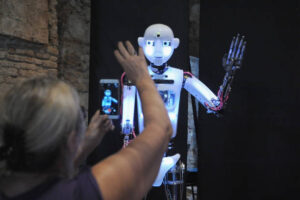Someone who is seeing this STEM vs STEAM vs STREAM acronym for the first time will ask what it stands for. Before we go into explaining them to you, we’ll see how they help kids and teenagers in education.
They are educational structures used in teaching kids to understand the technology world and the overall fields of study.
Moreso, in trying to explain STEM vs STEAM vs STREAM, we understand that STEM is a curriculum that combines Science, Technology, Engineering, and Math. STEAM is an advanced version, with the introduction of Arts.
STREAM is the most recent update to the acronym, with the introduction of Reading and Literature, that promises a better education process for your Children.
Having seen that, above, let us dive deep into the full explanation and how these concepts will benefit the students and pupils.
What Is STEM?
STEM is an education curriculum that combines science, technology, engineering, and mathematics. It is considered to be a comprehensive approach.
Therefore, educators, instead of teaching all these subjects separately, focus on incorporating some or all of STEM into each project.
Some of the most popular STEM projects are basic computer programming and bridge building, and the opportunities are infinite.
Importance of STEM Education
The reason STEM is important is integration. STEM lessons are well-rounded, inquiry-based, and project-based while focusing on interdisciplinary learning instead of teaching each subject independently.
This type of education aligns perfectly with the way we solve problems in life and the way we work, which is why it is considered to be an exceptional way of learning and instructing.
STEM and STEAM curricula focus on teaching children skills the way they will be used in the real world. There are rare cases when a job requires only one subject like math.
For example, an architect would use engineering, math, science, and technology during their work.
How Does STEM Improve Student Learning?
Most jobs in the world we see today are interdisciplinary. Therefore, teaching children how all these subjects work together is important.
STEM can help children develop more diverse skills, and make them passionate about growth and exploration.
Education should not be about memorizing random facts. Instead, it should help children develop critical thinking, and teach them how to evaluate information.
STEM emphasizes the 4 Cs that are required in this century: Creativity, Communication, Critical Thinking, and Collaboration.
Problems With STEM Education
The lack of resources for STEM education is one of the biggest problems.
Providing funds for the latest technology, training the current teachers in how to use them, and learning how to use the new technology effectively as a learning tool are places where teachers struggle.
If you have a healthy budget or if you are planning on teaching your children at home, go for the STEM kits. These are amazing ways to get started with STEM, and you will be able to find one for all ages.
Another problem is that the system is completely focused on grades and assessments, instead of encouraging a program that fosters problem-solving skills, creativity, critical thinking skills, and innovation.
Achievements in these areas are not something that can be easily assessed.
How to Make Your Child Interested In STEM
The best thing about STEM education is that it aligns with the way the minds of children work and learn. Therefore, the best way to make a child interested in STEM is to encourage curiosity.
From a young age, encourage kids to explore, question, and play. This can help them find their passion, and even though they may change their passions every week, encourage them!
STEM education will help children become innovative, creative adults with exceptional problem-solving and critical-thinking skills.
These skills are necessary for future generations, because of the increasing technology in the world.
What Is STEAM?
STEAM is the integration of Arts in STEM. This is because creative skills with knowledge of arts, such as history, writing, and design, are believed to help STEM employees find better innovative solutions to problems.
STEAM incorporates all the elements of STEM, but adds art to the mix.
STEAM focuses on the study of language arts, humanities, dance, music, drama, visual arts, new media, design, and more.
Children who explore these areas and master at least one of them can make themselves better candidates in the workforce today.
This is because about 57 percent of senior leaders at various companies give soft skills more value.
Importance of STEAM
STEAM type of education in schools provides children opportunities to learn creatively, making use of various 21st-century skills.
These general skills are important for creating a future-ready workforce that clearly understands the potential of questioning while solving real-life problems.
But, what happens when you add in the A for art? You have STEAM, which gives STEM a whole new look and feel.
Suddenly, a hands-on activity includes artistic ventures. This can allow students who don’t feel scientifically or mathematically inclined to feel more comfortable representing their knowledge
Future of STEAM
We all know how science, technology, engineering, & math help us understand how problems of the world can be solved with logic and technical skills.
Also, it helps in understanding how processes and fundamentals work together.
However, it lacks promotion of the creative and innovative skills in the process.
Also, while one may know that a particular problem is solvable using technologies around them, they might not come up with an innovative aspect to make it more beautiful and customizable.
So, the addition of Art becomes necessary which promotes the creative and artistic thinking of an individual.
Hence, STEAM helps an individual to come up with artistic and innovative ideas to solve any problem with opportunities available in science & technology.
What is STREAM?
STREAM stands for Science, Technology, Reading & wRiting, Engineering, Arts, and Maths. It adds up Reading & wRiting to STEAM. Real-world jobs are multidisciplinary. Children benefit from STREAM’s interdisciplinary approach to learning because it demonstrates how different disciplines interact.
They get the chance to explore, which helps them build the variety of skills needed for jobs in the future.
In STREAM, reading and writing are skills that are essential to a child’s education and can be applied to their future jobs. It’s beneficial that they learn these skills at an early age so they can develop them into adulthood.
Reading and writing help children learn about the world around them and their place in it.
They also help children appreciate different types of literature, which can help them become well-rounded adults who respect others’ opinions, ideas, and cultures.
STREAM projects and activities enable children to apply their knowledge in practical settings and train them to think critically and become future leaders.
Benefits of STREAM over STEM?
STREAM is beneficial because it allows students to learn core & most vital skills such as critical thinking, problem-solving, and combining innovative & collaborative ideas with today’s technology and tech opportunities.
As STREAM adds Reading & writing to the prior concept of STEAM, it strengthens the process to the next level.
STREAM takes care of overall requirements in the education curriculum. Hence, it’s more interesting and effective compared to the older two variations of STEM and STEAM.
Moreover, it’s a fact that if we want to produce highly skilled, innovative, and qualified scientists then writing & reading need to be the skills that they cherish & love to practice.
Conclusion
The vision of STEM education has always been to help students identify their passion and become a productive part of society by utilizing their passion.
But, as it was not promoting enough innovative and creative thinking which is a must to identify one’s passion, the addition of Arts and Reading was introduced. Although they make a good combination to improve learning for kids and adults.
Learning isn’t about grades alone, the creative river of every child must be put to good use.
Creativity is a gift to be nurtured appropriately.
Now, you have a clear understanding of STEM vs STEAM vs STREAM education and their roles.
You can also see the reason why STEAM education is important.




